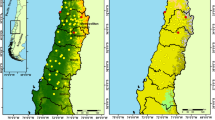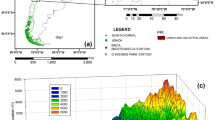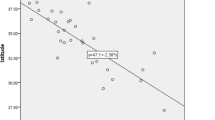Abstract
Tropical Ecuador presents a unique climate in which we study the relationship between the ambient levels of solar ultraviolet radiation and eye disease in the absence of a latitudinal gradient. The national distribution of surface ultraviolet, taking into account MODIS and OMI satellite observation of aerosol, ozone, surface albedo, local elevation and cloud fractions measured during 2011, was compared with the national pterygium (WHO ICD H11) and senile cataract (WHO ICD H25) incidence projected from the 2010 National Institute of Statistics and Census (Ecuador). Public Health Ministry projections for age categories 0 to 39, 40 to 59 and 60+ years were compared to surface ultraviolet irradiance data in 1040 parishes. Correlations drawn between modelled surface ultraviolet and eye disease incidence show a significant increase in both pterygium and senile cataract in the highest ambient exposure regions of the Pacific coast and western lowlands with incidence rates of 34.39 and 16.17 per 100 000 residents respectively. The lowest rates of incidence for pterygium (6.89 per 100 000) and senile cataract (2.90 per 100 000) were determined in high altitude sites and are attributed here to increased daily cloud fraction for parishes located in the Andean mountain range. The South American Andes experience the highest solar UV exposures on Earth and report frequent high incidence of keratinocyte cancer. Our results show the high Andes to be the location of the lowest eye disease incidence suggesting that both pterygium and senile cataract are the result of cumulative exposure to solar ultraviolet. These findings have clear implications for the agricultural workers and fishermen of the lowland districts of Ecuador, contrary to conventional understanding that greater risks are faced in locations of high altitude.
Similar content being viewed by others
References
R. Lucas and A.-L. Ponsonby, Prog. Biophys. Mol. Biol., 2006, 92, 140–149.
IARC, IARC Monographs on the evaluation of carcinogenic Risks to Humans, IARC International Agency for Research on Cancer Technical Report, 1992, vol. 55.
R. Lucas, T. McMichael, W. Smith and B. Armstrong, Solar ultraviolet radiation: Global burden of disease from solar ultraviolet radiation, World Health Organisation Technical Report Environmental Burden of Disease Series, No. 13, 2006.
Y. Cheng, J. H. Barrett, D. T. Bishop, B. K. Armstrong, V. Bataille, W. Bergman, M. Berwick, P. M. Bracci, J. M. Elwood, M. S. Ernstoff, R. P. Gallagher, A. C. Green, N. A. Gruis, E. A. Holly, C. Ingvar, P. A. Kanetsky, M. R. Karagas, T. K. Lee, L. LeMarchand, R. M. Mackie, H. Olsson, A. Osterlind, T. R. Rebbeck, P. Sasieni, V. Siskind, A. J. Swerdlow, L. Titus-Ernstoff, M. S. Zens and J. A. Newton-Bishop, Int. J. Epidemiol., 2009, 38, 814–830.
S. Harrison, R. Speare, I. Wronski and R. MacLennan, Lancet, 1994, 344, 1529–1532.
J. Rivers, R. MacLennan, J. Kelly, A. Lewis, B. Tate, S. Harrison and W. McCarthy, J. Am. Acad. Dermatol., 1995, 32, 957–963.
S. Harrison, R. MacKie and R. MacLennan, J. Natl. Cancer Inst., 2000, 92, 1436–1438.
C. Wright, R. Albers, A. Mathee, Z. Kunene, C. D'Este, A. Swaminathan and R. Lucas, BMC Public Health, 2017, 17, 37.
WHO, Atlas of Health and Climate, WHO World Health Organisation Technical Report, 2012.
A. Cullen, Int. J. Toxicol., 2002, 21, 455–464.
A. Cullen, Eye Contact Lens, 2011, 37, 185–190.
M. Tucker, J. Shields, P. Hartage, J. Augsburger, R. Hoover and J. Fraumeni, N. Engl. J. Med., 1985, 313, 789–792.
L. Robman and H. Taylor, Eye, 2005, 19, 1074–1082.
R. Bourne, G. Stevens, R. White, J. Smith, S. Flaxman, H. Price, J. Jonas, J. Keeffe, J. Leasher, K. Naidoo, K. Pesudovs, S. Resnikoff and H. Taylor, Lancet Glob. Health, 2013, 1, e339–e349.
C. McCarty, M. B. Nanjan and H. Taylor, Invest. Ophthalmol. Visual Sci., 2000, 41, 3720–3725.
S. West, B. Munoz and E. Emmett, Arch. Ophthalmol., 1989, 107, 1166–1169.
J. Seddon, D. Fong, S. West and C. Valmadrid, Surv. Ophthalmol., 1995, 39, 323–334.
F. Ederer, R. Hiller and H. Taylor, Am. J. Ophthalmol., 1981, 91, 381–395.
P. Dollin, Br.J. Ophthalmol., 1994, 78, 478–482.
C. McCarty and H. Taylor, in Progress in Lens and cataract Research, ed. O. Hockwin, M. Kojima, N. Takahashi and D. Sliney, Karger, Basel, 2002, vol. 35, pp. 21–31, ch. A review of the epidemiologic evidence linking ultraviolet radiation and cataracts.
S.-M. Saw and D. Tan, Ophthalmic Epidemiol., 1999, 6, 219–228.
T. Threlfall and D. English, Am. J. Ophthalmol., 1999, 128, 208–287.
J. Rojas and H. Málaga, Ann. Ophthalmol., 1986, 18, 147–149.
P. Lu, X. Chen, Y. Kang, L. Ke, X. Wei and W. Zhang, Clin. Exp. Ophthalmol., 2007, 35, 828–833.
M. Blumthaler, W. Ambach and R. Ellinger, J. Photochem. Photobiol., B, 1997, 39, 130–134.
NASA, NASA Distributed Active Archive Center (DAAC) at NSIDC: MODIS Data Moderate Resolution Imaging Spectro-radiometer: Terra vs Aqua, 2017a, https://nsidc.org/data/modis/terra_aqua_differences.
NASA, Level-1 and Atmosphere Archive Distribution System, 2017b, https://ladsweb.modaps.eosdis.nasa.gov/.
A. Green, T. Sawada and E. Shettle, Photochem. Photobiol., 1974, 19, 251–259.
A. Green, K. Cross and L. Smith, Photochem. Photobiol., 1980, 31, 59–65.
P. Schippnick and A. Green, Photochem. Photobiol., 1982, 35, 89–101.
R. Rundel, in Stratospheric Ozone Reduction, Solar Ultraviolet Radiation and Plant Life, ed. R. Worrest and M. Caldwell, Springer-Verlag, Berlin, 1986, ch. Computation of Spectral Distribution and Intensity of Solar UVB Radiation.
J. Sabburg, A. Parisi and J. Wong, Photochem. Photobiol., 2001, 74, 412–416.
J. Sabburg, A. Parisi, J. Wong and L. Meldrum, J. Atmos. Sol.-Terr. Phys., 2001, 63, 1623–1629.
CIE, CIE J., 1987, 6, 17–22.
M. Kimlin, J. Sabburg, A. Parisi and R. Meltzer, J. Atmos. Sol.-Terr. Phys., 2003, 65, 1401–1410.
N. Downs, A. Parisi, J. Turner and D. Turnbull, Photochem. Photobiol. Sci., 2008, 7, 700–710.
R. Deo, N. Downs, A. Parisi, J. Adamowski and J. Quilty, Environ. Res., 2017, 155, 141–166.
W. Josefsson, SMHI Sweedish Meteorological and Hydrological Institute Reports: Meteorol. Climatol., 1986, vol. 53, pp. 34–39.
C. Amante and B. Eakins, ETOPO1 1 arc-minute global relief model: procedures, data sources and analysis, 2009, https://www.ngdc.noaa.gov/docucomp/page?xml=NOAA/NESDIS/NGDC/MGG/DEM/iso/xml/316.xml&view=getDataView&header=none.
NASA, GIOVANNI Ozone Total Column (DOAS), 2017c, https://giovanni.gsfc.nasa.gov/giovanni/.
M. Pfeifer, P. Koepke and J. Reuder, J. Geophys. Res., 2006, 111, D01203.
U. Feister and R. Grewe, Photochem. Photobiol., 1995, 62, 736–744.
B. Diffey, C. Jansèn, F. Urbach and H. Wulf, Photodermatol., Photoimmunol. Photomed., 1997, 13, 64–66.
G. Valdivieso, E. Stefos and R. Lalama, Rev. Europe. Stud., 2017, 9, 120–129.
D. Moran and F. Hollows, Br. J. Ophthalmol., 1984, 68, 343–346.
F. Hollows and D. Moran, Lancet, 1981, 318, 1249–1250.
A. Piedehierro, M. Anton, A. Cazorla, A. Alados-Arboledas and F. Olmo, Atmos. Res., 2014, 135-136, 1–7.
U. Feister, N. Cabrol and D. Häder, Atmosphere, 2015, 6, 1211–1228.
L. Suàrez, J. F. Rojas, A. P. Filho and H. Karam, Photochem. Photobiol. Sci., 2017, 16, 954–971.
N. Cabrol, U. Feister, D.-P. Häder, H. Piazena, E. Grin and A. Klein, Front. Environ. Sci., 2014, 2, 1–5.
R. McKenzie, J. Liley and S. Madronich, Photochem. Photobiol. Sci., 2017, 16, 785–794.
R. Arjona, J. Pineiros, M. Ayabaca and F. Freire, Ann. Ist. Super. Sanita, 2016, 52, 368–373.
D. Sliney, J. Photochem. Photobiol., B, 1995, 31, 69–77.
D. Mateos, J. Bilbao, A. D. Miguel and A. Pèrez-Burgos, Atmos. Res., 2010, 98, 21–27.
Acknowledgements
The authors gratefully accept the support of the Ministry for Public Health, Ecuador for providing the 2015 parish projections of pterygium and cataract incidence from the National Institute of Statistics and Census. We acknowledge the National Oceanic and Atmospheric Administration, NOAA (US) for access to the ETOPO1 Global relief model used to derive local surface topography, and the GIOVANNI remote sensing archive (Goddard Earth Sciences Data and Information Services Center, NASA) which listed the OMI and MODIS remote sensing products utilised in this study. We acknowledge the support of the Instituto Nacional de Investigación en Salud Pública (Ecuador), Universidad San Francisco de Quito (Ecuador), James Cook University (Australia) and the University of Southern Queensland (Australia). The authors also give special thanks to Alex Rawlings (Research Assistant) for processing the remote sensing parameters utilised in creating the surface UV exposure maps.
Author information
Authors and Affiliations
Corresponding author
Rights and permissions
About this article
Cite this article
Garzon-Chavez, D.R., Quentin, E., Harrison, S.L. et al. The geospatial relationship of pterygium and senile cataract with ambient solar ultraviolet in tropical Ecuador. Photochem Photobiol Sci 17, 1075–1083 (2018). https://doi.org/10.1039/c8pp00023a
Received:
Accepted:
Published:
Issue Date:
DOI: https://doi.org/10.1039/c8pp00023a




